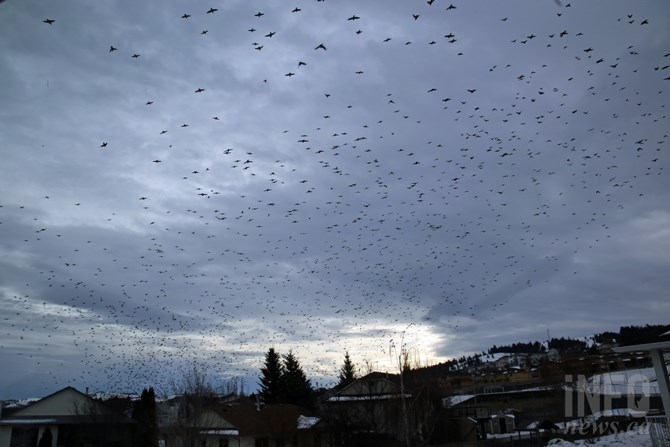
The Christmas bird count, has a long history in the region as a social event that gathers useful data examined on a national scale.
(JENNIFER STAHN / iNFOnews.ca)
December 21, 2018 - 6:30 PM
PENTICTON - A B.C. Interior Christmas tradition continues as the 2018 Christmas bird count takes place throughout the region.
The bird counts take place in various locations, on a day selected within two weeks of Christmas. Christmas bird counts have been conducted in the region for almost as long as the counts themselves have been taking place in North America.
Author Steve Cannings wrote about the bird counts in the 1987 Okanagan Historical Society Annual Report. He noted the earliest Okanagan bird count occurred in 1905, only five years after the very first event was held in 25 locations throughout Canada and the U.S. in 1900.
The bird counts were developed as a more environmentally-friendly alternative to a prevailing Christmas outdoor custom of the day that involved going out and shooting as many birds - and other moving things - as possible. The counts were eventually adopted by the National Audubon Society.
Notable bird count pioneers included such names as Major Allan Brooks of Okanagan Landing in Vernon, who recorded 27 species and 137 wintering birds in the early 1900s. Naramata pioneer fruit grower J.M. Schreck organized several Christmas bird counts in the 1920s, as did Eric Tait, Herbert Simpson and Joe Liddell in the Penticton-Summerland area. Vernon resident Jim Grant organized many of the counts in that city in the 1950s.
The purpose of the Christmas bird count is to record as many species as possible in a given area in a single calendar day. Count areas are limited to a 15-mile radius, and searched by parties of participants who report the results at the end of the day, generally making a social occasion out of it. Participants can spend up to eight hours in the field while counting.
Okanagan bird counts hold some all-time records for the highest counts in North America for some species in certain years. A bird of note seen and recorded in the mid-1980s was the Anna's hummingbird, which was found to be increasing in numbers for several years in the 1980s.
Cannings also noted in the report that Canada Geese were once scarce in the first days of the count in the 1920s, with only five geese counted in 1929. Counts in the 1980s saw increases in the number of ring-billed gulls, mourning doves, Anna's hummingbirds, American robins, Stellar’s jays, house finches and house sparrows.
Modern Christmas bird counts
The local Christmas counts continue to thrive in modern times.
South Okanagan-West Kootenay MP, biologist and birder Dick Cannings takes part in the Christmas bird counts in the South Okanagan. He says counts have increased in number across Canada in recent years with well over 400 now taking place across the country.
"Here in the Okanagan there are at least a dozen taking place... Some counts are already completed,” he says.
More than 80 birders turned out the Bishop Bird Sanctuary in Vernon on Dec. 16 for Vernon's 69th annual bird count.
Cannings says this year there has been a notable increase in the robin count, more than 1,000 on the recently completed Penticton bird count, compared to a normal count of between 100 and 150. The Vernon count recorded 763 robins, up from 54 last year.
“It’s probably due to the warm fall we’ve been experiencing. There’s been a notable decrease in the number of winter birds counted so far, such as chickadees, likely for a similar reason. They may be staying at higher altitudes,” he says.
Cannings says the Thompson-Okanagan bird counts are important in the national data gathering process, which requires a country-wide count because birds can, and do move around a lot. The bird counts are a good way to monitor the state of the environment because birds as a species are easy to count and there is a vast network of birders set up to do it.
Local bird counts have recently noticed a big increase in the Eurasian collared dove, with 200 counted in Penticton last week.
“They never used to be here, but they’ve increased greatly in the past few years,” Cannings says, attributing the increase to improving habitat for the birds, who like nesting and feeding around homes, gardens and backyards.
Cannings says the bird counts are highly social events that gather a lot of important data.
He says volunteers are always welcome, with several bird counts still left to be done in the region. Anyone wishing to volunteer can contact Cannings by sending an email to dickcannings@shaw.ca.
For a list of bird counts in the province and region go to the B.C. Field Ornithologists website here.
To contact a reporter for this story, email Steve Arstad or call 250-488-3065 or email the editor. You can also submit photos, videos or news tips to the newsroom and be entered to win a monthly prize draw.
We welcome your comments and opinions on our stories but play nice. We won't censor or delete comments unless they contain off-topic statements or links, unnecessary vulgarity, false facts, spam or obviously fake profiles. If you have any concerns about what you see in comments, email the editor in the link above.
News from © iNFOnews, 2018